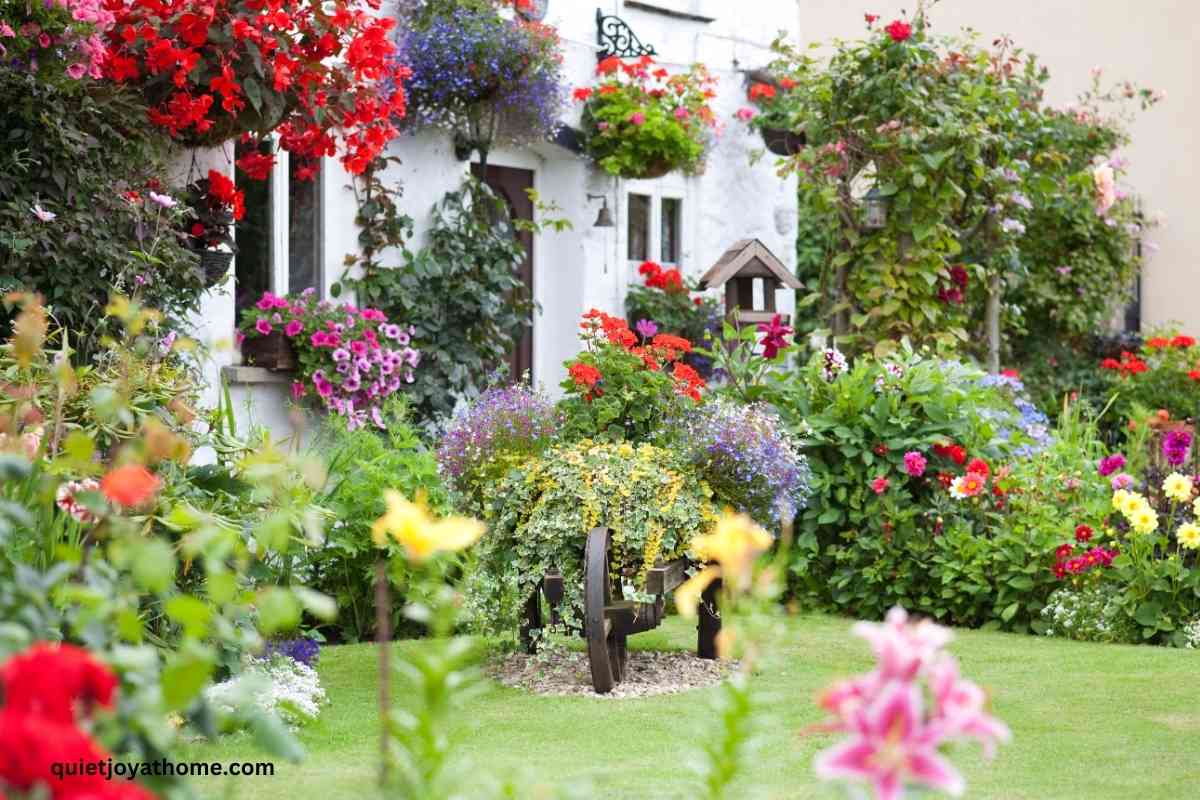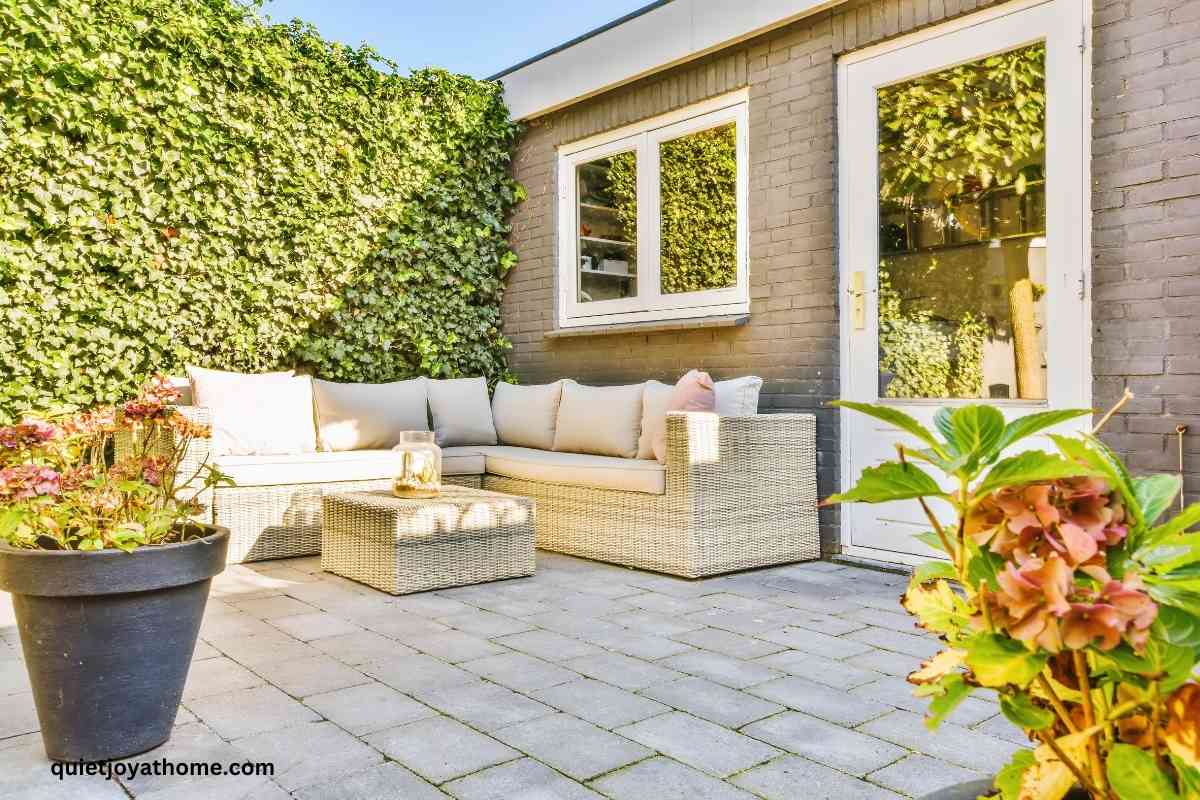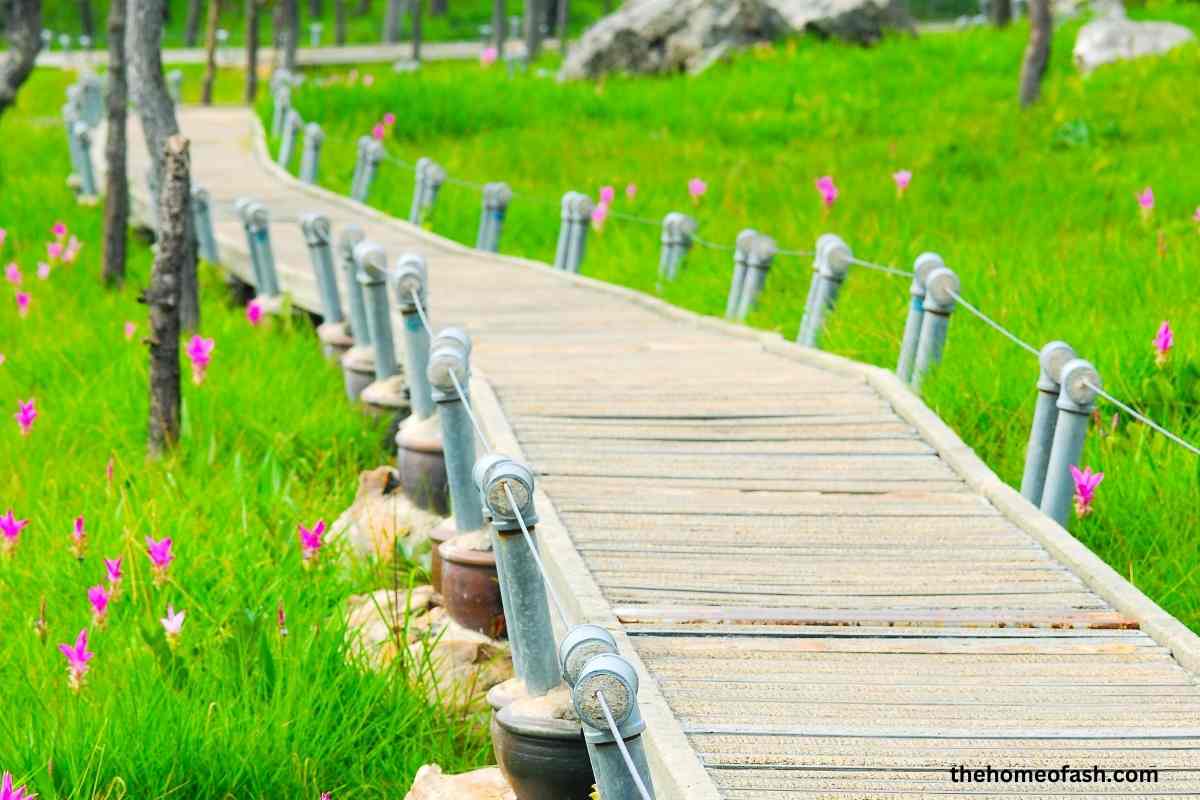I absolutely love spending time in my garden, especially during the warmer months. There’s something so peaceful and rejuvenating about being surrounded by beautiful flowers and lush greenery. That’s why I’m excited to share with you some of my favorite English garden ideas.

English gardens are known for their romantic, naturalistic style, featuring a mix of perennials, annuals, and shrubs that create a relaxed and inviting atmosphere. Whether you have a small balcony or a sprawling backyard, there are plenty of ways to incorporate this timeless look into your outdoor space. From charming cottage gardens to elegant formal designs, these ideas are sure to inspire your own garden oasis.
1) Cottage Garden Pathways

As I walk through my English garden, the winding pathways lined with colorful flowers and lush greenery always catch my eye. Cottage garden pathways are a charming addition to any garden, providing a whimsical and inviting atmosphere. I love using natural materials like stone or gravel to create a rustic feel, and adding arches or trellises for climbing plants to create a sense of enchantment. A cottage garden pathway is the perfect way to add character and personality to your outdoor space.
2) Topiary Art
I absolutely adore topiary art! It’s a unique way to add some character to your garden. You can shape your shrubs and trees into anything you want, from animals to geometric shapes. I love seeing the creativity that goes into each design. It’s a great way to showcase your personality and style in your garden. Plus, it’s always a conversation starter when guests come over. Give it a try and see how much fun it can be!
3) Rose Arbors
I absolutely love rose arbors in English gardens. They add a touch of romance and elegance to any outdoor space. There’s something so charming about walking through an arbor covered in beautiful roses.
When it comes to choosing the right roses for your arbor, I recommend going for climbing or rambling varieties. They will grow up and over the structure, creating a stunning display of blooms. Don’t forget to prune them regularly to keep them in shape and encourage healthy growth.
4) Herbaceous Borders
I absolutely love herbaceous borders in English gardens! They are a beautiful way to add color and texture to any garden. These borders are typically filled with a variety of perennial plants that bloom at different times throughout the year, creating a constantly changing display of color.
When planning a herbaceous border, it’s important to consider the height and color of each plant, as well as their blooming season. This will help ensure that your border looks beautiful all year round. Some popular plants for herbaceous borders include lavender, salvia, and delphiniums.
Overall, herbaceous borders are a great way to add interest and beauty to any English garden.
5) Water Features

Adding a water feature to your English garden can create a peaceful and relaxing atmosphere. I love the sound of running water, so I added a small pond with a fountain. It’s a great place to sit and unwind after a long day. If you don’t have the space for a pond, a simple birdbath or a small water fountain can still add a calming element to your garden. Just make sure to keep the water clean and fresh.
6) Wildflower Meadows

I absolutely love the idea of incorporating wildflower meadows into English gardens. They add a natural and effortless beauty to any space. Plus, they attract all sorts of pollinators like bees and butterflies. To create a wildflower meadow, I recommend choosing a mix of native wildflowers that will thrive in your area. Plant them in a sunny spot with well-drained soil and let them grow wild. It’s a low-maintenance and eco-friendly way to add some charm to your garden.
7) Garden Sheds
I love garden sheds! They are the perfect addition to any garden. Not only do they provide extra storage space for tools and equipment, but they can also be used as a workspace for gardening projects. Garden sheds come in all shapes and sizes, from traditional wooden designs to modern metal structures. You can even customize them to match your garden’s style and color scheme. A garden shed is a must-have for any serious gardener.
8) Pergolas

Pergolas are a fantastic way to add some character and charm to your garden. They can be used to create a shaded area, or to support climbing plants such as roses or ivy. I love the way that they can be customized to fit any style of garden, from traditional to modern. They also provide a great focal point for a garden, and can be used to frame a view or create a sense of enclosure. If you’re looking for a way to add some interest to your garden, a pergola is definitely worth considering.
9) Garden Benches
I love garden benches! They are an excellent addition to any garden, providing a comfortable spot to sit and enjoy the beauty of nature. With so many styles and materials to choose from, it’s easy to find one that fits your garden’s theme. Wooden benches are classic and timeless, while metal benches are sturdy and modern. You can also add cushions and pillows to make them even more comfortable. Don’t forget to place them in a shady spot for those hot summer days!
10) Bird Baths

As I was planning my English garden, I knew I wanted to include a bird bath. Not only do they add a charming touch to any garden, but they also provide a source of water for birds to bathe and drink from. I opted for a simple stone bird bath, which blends seamlessly into the natural surroundings. It’s been a joy watching various bird species make use of it throughout the day. I highly recommend adding a bird bath to your garden if you haven’t already!
11) Sundials

As I wander through different English gardens, I can’t help but notice the charm of sundials. These ancient timepieces add a classic touch to any garden, and they’re surprisingly accurate too. I particularly love the intricate designs of sundials, which often feature zodiac signs or other symbols. They make for a great focal point in any garden and are perfect for those who love history and tradition. If you’re looking to add a touch of elegance to your garden, consider a sundial.
12) Climbing Roses
I absolutely adore climbing roses in English gardens. They add a touch of elegance and romance to any outdoor space. I particularly love the way they climb up trellises, walls, and arches. They come in a variety of colors, from soft pinks to deep reds, and their fragrant blooms are simply stunning. Climbing roses require a bit of maintenance, but the effort is well worth it for the beauty they bring to your garden.
13) Lavender Hedges
Lavender hedges are a perfect addition to any English garden. They are not only beautiful, but also practical, as they can be used to create a natural border around your garden. The scent of lavender is also known to have a calming effect, making it a great addition to any outdoor space. I love the way the purple flowers look against the green foliage and how they attract bees and butterflies. Lavender hedges are easy to maintain and can be trimmed to any size or shape.
14) Boxwood Edging
I absolutely love using boxwood edging in my English garden designs. It’s a classic and timeless look that adds structure and definition to any garden bed. Plus, it’s easy to maintain and stays green all year round. Boxwood also pairs well with a variety of other plants and flowers, making it a versatile choice for any garden style. Whether you’re going for a formal or informal look, boxwood edging is a great option to consider.
15) Garden Statues
I love adding garden statues to my English garden. They can be a great focal point and add a touch of elegance and charm. From classical Greek and Roman figures to whimsical animals, there are many options to choose from. Stone, bronze, and concrete are popular materials, but you can also find resin and ceramic statues that are more affordable. Just be sure to choose a statue that fits the scale and style of your garden.
16) Wisteria Trellises
I absolutely love the look of wisteria trellises in an English garden. These beautiful vines can add a touch of elegance and romance to any outdoor space. The delicate purple flowers are simply stunning and the fragrance is heavenly.
When it comes to creating a wisteria trellis, it’s important to choose a sturdy structure that can support the weight of the vines. I recommend using a metal or wooden trellis that is firmly anchored in the ground. Be sure to plant your wisteria in a spot that gets plenty of sunlight and has well-draining soil.
With a little bit of care and patience, your wisteria trellis will be the envy of all your friends and neighbors.
Pond Plants
When it comes to adding plants to your pond, there are plenty of options to choose from. I personally love water lilies, which come in a variety of colors and can add a pop of vibrancy to your pond. Other popular pond plants include lotus, water hyacinth, and water lettuce. Just make sure to choose plants that are suitable for your specific pond size and climate. Adding pond plants not only enhances the aesthetic appeal of your garden but also provides a natural habitat for aquatic life.
18) Garden Lighting

I absolutely love the way garden lighting can transform an outdoor space into a magical wonderland. From simple string lights to elegant lanterns, there are so many options to choose from. I personally like to use solar-powered lights, which not only save energy but also eliminate the need for pesky cords. And don’t forget about highlighting specific features in your garden, like a beautiful tree or a water feature, with spotlights. The possibilities are endless when it comes to garden lighting!
19) English Ivy Walls
I absolutely love the look of English ivy growing up a wall. It adds a touch of old-world charm to any garden. Not only is it beautiful, but it also serves as a natural insulator, keeping your home cooler in the summer and warmer in the winter.
When planting English ivy, make sure to choose a location with partial shade and well-drained soil. It’s important to train the ivy to grow up the wall using a trellis or wire frame. Once it’s established, it requires minimal maintenance and will continue to thrive for years to come.
20) Garden Gates
Garden gates are an essential element of any English garden. They not only provide security but also add to the overall aesthetic of the garden. When choosing a garden gate, consider the style of your garden and the architecture of your home. A wooden gate with a rustic finish is perfect for a cottage-style garden, while a wrought iron gate adds elegance to a formal garden. I personally love the look of a garden gate covered in climbing roses or ivy, adding a touch of whimsy to the entrance.
Benefits of an English Garden
As an avid gardener, I can attest to the numerous benefits of having an English garden. Here are a few reasons why I believe everyone should consider having one:
Aesthetic Appeal
One of the primary benefits of an English garden is its aesthetic appeal. English gardens are known for their beauty and charm, with an emphasis on naturalistic planting and an abundance of flowers. The use of traditional materials such as brick and stone also adds to the overall look and feel of the garden. Whether you prefer a formal or informal style, an English garden can be tailored to your personal taste and style.
Biodiversity
Another benefit of an English garden is the biodiversity it can provide. English gardens are designed to be wildlife-friendly, with a variety of plants, shrubs, and trees that attract birds, bees, and other beneficial insects. This not only helps to support local ecosystems but also adds to the overall health of the garden. By creating a diverse and balanced ecosystem, you can reduce the need for pesticides and other harmful chemicals, making your garden safer for both people and wildlife.
In summary, an English garden is not only beautiful but also beneficial for the environment. By incorporating naturalistic planting and creating a diverse ecosystem, you can enjoy a stunning garden while also supporting local wildlife and reducing your impact on the environment.
Design Principles of English Gardens

Symmetry and Balance
When it comes to designing an English garden, symmetry and balance are essential principles. I always strive to create a sense of harmony and balance in my garden designs. This can be achieved by placing identical or similar elements on either side of a central axis. For example, I might place a pair of topiaries or fountains on either side of a garden path to create a sense of symmetry.
Use of Perennials
Another important design principle in English gardens is the use of perennials. Perennials are plants that come back year after year, and they are a staple in English garden design. I love to use perennials like roses, lavender, and peonies to add color and texture to my garden beds. By choosing a variety of perennials that bloom at different times throughout the year, I can ensure that my garden always has something in bloom.
Overall, when designing an English garden, it’s important to keep in mind the principles of symmetry and balance, as well as the use of perennials. By incorporating these principles into your garden design, you can create a beautiful and timeless space that will bring you joy for years to come.
Maintenance Tips for English Gardens

Pruning Techniques
As a gardener, I know how important it is to prune your plants regularly to keep them healthy and looking their best. When it comes to English gardens, pruning is essential to maintain the traditional look and feel of the space. Here are a few pruning techniques that I find helpful:
- Deadheading: Removing spent flowers helps to encourage new growth and prolongs the blooming period of your plants.
- Shaping: Use shears to trim your plants into the desired shape and size. This is especially important for hedges and topiaries.
- Thinning: Remove any dead, diseased, or damaged branches to promote healthy growth and prevent the spread of disease.
Seasonal Care
English gardens require different levels of care throughout the year. Here are some seasonal care tips to keep your garden looking its best:
- Spring: As the weather warms up, it’s time to start planting new flowers and vegetables. Be sure to fertilize your plants and prune any winter damage.
- Summer: Keep your garden well-watered and mulched to retain moisture. Deadhead your flowers regularly and keep an eye out for pests and diseases.
- Fall: Prepare your garden for winter by removing any dead plants and adding a layer of compost. Plant bulbs for spring blooms.
- Winter: Protect your garden from frost and snow by covering delicate plants and bringing potted plants indoors. Prune any winter damage and plan for next year’s garden.
Remember, regular maintenance is key to keeping your English garden looking its best. By following these pruning techniques and seasonal care tips, you can enjoy a beautiful and thriving garden all year round.




